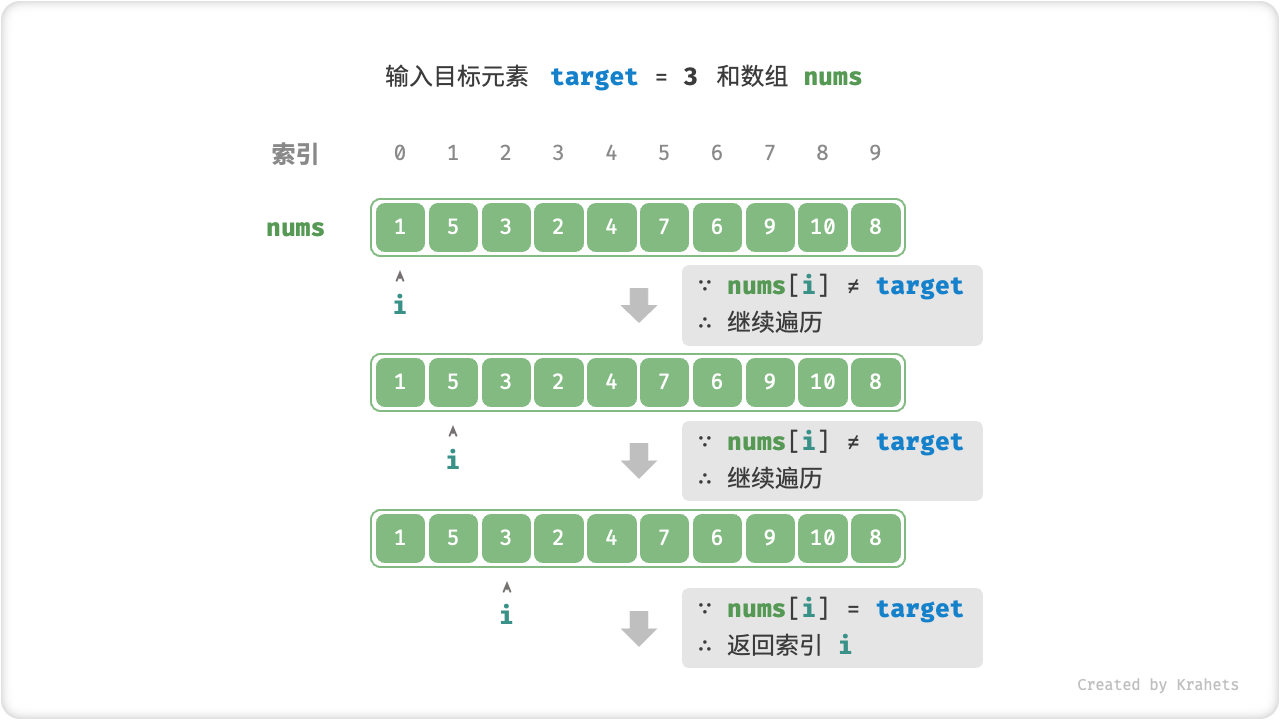10.1. 线性查找
「线性查找 Linear Search」是一种最基础的查找方法,其从数据结构的一端开始,依次访问每个元素,直到另一端后停止。
10.1.1. 算法实现
线性查找实质上就是遍历数据结构 + 判断条件。比如,我们想要在数组 nums 中查找目标元素 target 的对应索引,那么可以在数组中进行线性查找。

Fig. 在数组中线性查找元素
linear_search.java/* 线性查找(数组) */
int linearSearchArray(int[] nums, int target) {
// 遍历数组
for (int i = 0; i < nums.length; i++) {
// 找到目标元素,返回其索引
if (nums[i] == target)
return i;
}
// 未找到目标元素,返回 -1
return -1;
}
linear_search.cpp/* 线性查找(数组) */
int linearSearchArray(vector<int>& nums, int target) {
// 遍历数组
for (int i = 0; i < nums.size(); i++) {
// 找到目标元素,返回其索引
if (nums[i] == target)
return i;
}
// 未找到目标元素,返回 -1
return -1;
}
linear_search.pydef linear_search_array(nums: List[int], target: int) -> int:
""" 线性查找(数组) """
# 遍历数组
for i in range(len(nums)):
if nums[i] == target: # 找到目标元素,返回其索引
return i
return -1 # 未找到目标元素,返回 -1
linear_search.go/* 线性查找(数组) */
func linearSearchArray(nums []int, target int) int {
// 遍历数组
for i := 0; i < len(nums); i++ {
// 找到目标元素,返回其索引
if nums[i] == target {
return i
}
}
// 未找到目标元素,返回 -1
return -1
}
linear_search.js/* 线性查找(数组) */
function linearSearchArray(nums, target) {
// 遍历数组
for (let i = 0; i < nums.length; i++) {
// 找到目标元素,返回其索引
if (nums[i] === target) {
return i;
}
}
// 未找到目标元素,返回 -1
return -1;
}
linear_search.ts/* 线性查找(数组)*/
function linearSearchArray(nums: number[], target: number): number {
// 遍历数组
for (let i = 0; i < nums.length; i++) {
// 找到目标元素,返回其索引
if (nums[i] === target) {
return i;
}
}
// 未找到目标元素,返回 -1
return -1;
}
linear_search.c[class]{}-[func]{linearSearchArray}
linear_search.cs/* 线性查找(数组) */
int linearSearchArray(int[] nums, int target)
{
// 遍历数组
for (int i = 0; i < nums.Length; i++)
{
// 找到目标元素,返回其索引
if (nums[i] == target)
return i;
}
// 未找到目标元素,返回 -1
return -1;
}
linear_search.swift/* 线性查找(数组) */
func linearSearchArray(nums: [Int], target: Int) -> Int {
// 遍历数组
for i in nums.indices {
// 找到目标元素,返回其索引
if nums[i] == target {
return i
}
}
// 未找到目标元素,返回 -1
return -1
}
linear_search.zig// 线性查找(数组)
fn linearSearchArray(comptime T: type, nums: std.ArrayList(T), target: T) T {
// 遍历数组
for (nums.items) |num, i| {
// 找到目标元素, 返回其索引
if (num == target) {
return @intCast(T, i);
}
}
// 未找到目标元素,返回 -1
return -1;
}
再比如,我们想要在给定一个目标结点值 target ,返回此结点对象,也可以在链表中进行线性查找。
linear_search.java/* 线性查找(链表) */
ListNode linearSearchLinkedList(ListNode head, int target) {
// 遍历链表
while (head != null) {
// 找到目标结点,返回之
if (head.val == target)
return head;
head = head.next;
}
// 未找到目标结点,返回 null
return null;
}
linear_search.cpp/* 线性查找(链表) */
ListNode* linearSearchLinkedList(ListNode* head, int target) {
// 遍历链表
while (head != nullptr) {
// 找到目标结点,返回之
if (head->val == target)
return head;
head = head->next;
}
// 未找到目标结点,返回 nullptr
return nullptr;
}
linear_search.pydef linear_search_linkedlist(head: ListNode, target: int) -> Optional[ListNode]:
""" 线性查找(链表) """
# 遍历链表
while head:
if head.val == target: # 找到目标结点,返回之
return head
head = head.next
return None # 未找到目标结点,返回 None
linear_search.go/* 线性查找(链表) */
func linearSearchLinkedList(node *ListNode, target int) *ListNode {
// 遍历链表
for node != nil {
// 找到目标结点,返回之
if node.Val == target {
return node
}
node = node.Next
}
// 未找到目标元素,返回 nil
return nil
}
linear_search.js/* 线性查找(链表)*/
function linearSearchLinkedList(head, target) {
// 遍历链表
while(head) {
// 找到目标结点,返回之
if(head.val === target) {
return head;
}
head = head.next;
}
// 未找到目标结点,返回 null
return null;
}
linear_search.ts/* 线性查找(链表)*/
function linearSearchLinkedList(head: ListNode | null, target: number): ListNode | null {
// 遍历链表
while (head) {
// 找到目标结点,返回之
if (head.val === target) {
return head;
}
head = head.next;
}
// 未找到目标结点,返回 null
return null;
}
linear_search.c[class]{}-[func]{linearSearchLinkedList}
linear_search.cs/* 线性查找(链表) */
ListNode? linearSearchLinkedList(ListNode head, int target)
{
// 遍历链表
while (head != null)
{
// 找到目标结点,返回之
if (head.val == target)
return head;
head = head.next;
}
// 未找到目标结点,返回 null
return null;
}
linear_search.swift/* 线性查找(链表) */
func linearSearchLinkedList(head: ListNode?, target: Int) -> ListNode? {
var head = head
// 遍历链表
while head != nil {
// 找到目标结点,返回之
if head?.val == target {
return head
}
head = head?.next
}
// 未找到目标结点,返回 null
return nil
}
linear_search.zig// 线性查找(链表)
fn linearSearchLinkedList(comptime T: type, node: ?*inc.ListNode(T), target: T) ?*inc.ListNode(T) {
var head = node;
// 遍历链表
while (head != null) {
// 找到目标结点,返回之
if (head.?.val == target) return head;
head = head.?.next;
}
return null;
}
10.1.2. 复杂度分析
时间复杂度 \(O(n)\) :其中 \(n\) 为数组或链表长度。
空间复杂度 \(O(1)\) :无需使用额外空间。
10.1.3. 优点与缺点
线性查找的通用性极佳。由于线性查找是依次访问元素的,即没有跳跃访问元素,因此数组或链表皆适用。
线性查找的时间复杂度太高。在数据量 \(n\) 很大时,查找效率很低。
